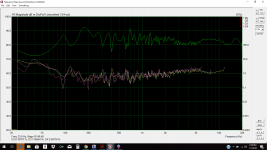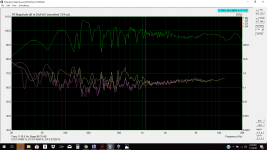That distortion plot isn't showing the distortion of the loudspeakers being measured, more just limitation in the measurement system itself.
It looks like you need far more signal to noise ratio to make anything useful happen. Usually this means turning it up.
It looks like you need far more signal to noise ratio to make anything useful happen. Usually this means turning it up.
HOW did you measure that? These measurements are quite different, the room influence is also clearly visible. The first thing you should do is to test your measurement chain. For a test if your soundcard is sufficient make a loopback test, output of the card (low level) into the mic input. That should come out pretty clean. If it desn't, the card is likely not good enough for distortion measurements. Besides that, didn't the manual of the software help in any way about THD measurements?
andy2, you are better off moving to near-field measurement than cranking up the volume. Set your level at 2.83 V, measure the FR at 1m. This will give you the actual output, but move in to within 1-3" for distortion measurements, without changing the level.
Answer the man! 🙂 Still, the last one is OK I would say. 0,15% at most and no special peaks etc looks OK.
Do they sound clean to you?
You measurements, are they dBv or dBp? They seem to be relative power which is a bit unusual. I measure distorsion levels 40-50 (60) dB down. You seem to have 30ish. I was surprised your software indicated 0,15% for this. 30dB down is not to good... THIS might still be a measurement problem as others has indicated. 0,15% dist is OK however.
Distortion (%) Relative Voltage Level (dB) Relative Power Level (dB)
0.01 -80 -40
0.05 -66 -33
0.10 -60 -30
0.50 -46 -23
1.00 -40 -20
5.00 -26 -13
10.0 -20 -10
//
Do they sound clean to you?
You measurements, are they dBv or dBp? They seem to be relative power which is a bit unusual. I measure distorsion levels 40-50 (60) dB down. You seem to have 30ish. I was surprised your software indicated 0,15% for this. 30dB down is not to good... THIS might still be a measurement problem as others has indicated. 0,15% dist is OK however.
Distortion (%) Relative Voltage Level (dB) Relative Power Level (dB)
0.01 -80 -40
0.05 -66 -33
0.10 -60 -30
0.50 -46 -23
1.00 -40 -20
5.00 -26 -13
10.0 -20 -10
//
Answer the man! 🙂 Still, the last one is OK I would say. 0,15% at most and no special peaks etc looks OK.
[...] I measure distorsion levels 40-50 (60) dB down. You seem to have 30ish. I was surprised your software indicated 0,15% for this. 30dB down is not to good... THIS might still be a measurement problem as others has indicated. 0,15% dist is OK however.
Don't you think it wouldn't be better to check first if the measurements are usable and significant before declaring them as ok?
Thanks for posting the %/dB table btw. (I was too lazy to search for it 😛)
Does it matter what the graph says with all it's unknown variables?Do they sound clean to you?
An indication that you are measuring loudspeaker distortion instead of the sound cards noise floor is when the harmonics have different levels. Usually D2 > D3 > D4 > D5 etc. , except at low frequencies, where the odd harmonics can be elevated.
Good idea, though near field distortion measurements might require a high SPL microphone. Otherwise your measurement could be dominated by microphone distortion.andy2, you are better off moving to near-field measurement than cranking up the volume.
Last edited:
An indication that you are measuring loudspeaker distortion instead of the sound cards noise floor is when the harmonics have different levels. Usually D2 > D3 > D4 > D5 etc. , except at low frequencies, where the odd harmonics can be elevated.
You are right, that's exactly what the measurement looks like. And that's also why I asked for a loopback measurement. I'm for a systematic check of the measurement chain, if not everything is checked, it's still just kinda an estimate.
Good idea, though near field distortion measurements might require a high SPL microphone. Otherwise your measurement could be dominated by microphone distortion.
That works only partly. Because you can only measure one driver at a time and you'd have to snip-snap the measurements together but at the crossover both play at the same time where the sound levels aswell as the distortion add up. And on big membranes you can't measure the distortion completely because of some partial cone movement, it may be too far away from the microphone. It doesn't matter that much for subs but if you are using a 15" 2-way woofer, it can make a big difference at higher frequencies.
The need for a high-spl mic is a very good tip. If the driver makes 89dB/1m it's already 111dB at 7,5cm at just 2,83V (or 1W @8Ohm )! That means most cheap measurement microphones are already at or even over the limit!
You measurements, are they dBv or dBp? They seem to be relative power which is a bit unusual.
I pretty much doubt it's a relative power measurement, the software doesn't have the possibility to measure the power on the fly through the microphone. And it doesn't make any sense either because the spl is measured by voltage, not power. If you mix the measurement methods, you can't read much out of it. For amps that's useful though but they are much easier to measure because you can use a constant/linear load.
Interesting, thanks, and above 1k they tend to even out?An indication that you are measuring loudspeaker distortion instead of the sound cards noise floor is when the harmonics have different levels. Usually D2 > D3 > D4 > D5 etc. , except at low frequencies, where the odd harmonics can be elevated.
^Not really, it just looks like that because these measurements are still at too low spl. If the measurement is done at 1,5 to 2m distance, most hifi tweeters will show distortion even with a crossover. Still some of distortion can be artefact from rattling enclosure or furniture etc.
I use Umik and it seems to starts distorting itself above 115dB (nearfield). My minidsp gets overloaded easier, if I use more than 105dB at 1,5m, but I never listen to music so loud. For really loud listening I would need amps with more gain.
I use Umik and it seems to starts distorting itself above 115dB (nearfield). My minidsp gets overloaded easier, if I use more than 105dB at 1,5m, but I never listen to music so loud. For really loud listening I would need amps with more gain.
I measure distorsion levels 40-50 (60) dB down. You seem to have 30ish.
That's about what I get when I do distortion measurements.
I try to keep all my measurements the same (distance and SPL), so It's easier to understand the relative differences between drivers or finished speakers.
I measure partly out of curiosity but the main reason Is to check for any glaringly obvious faults.
- Status
- Not open for further replies.
- Home
- Loudspeakers
- Multi-Way
- Is this distortion level considered "acceptable"?

